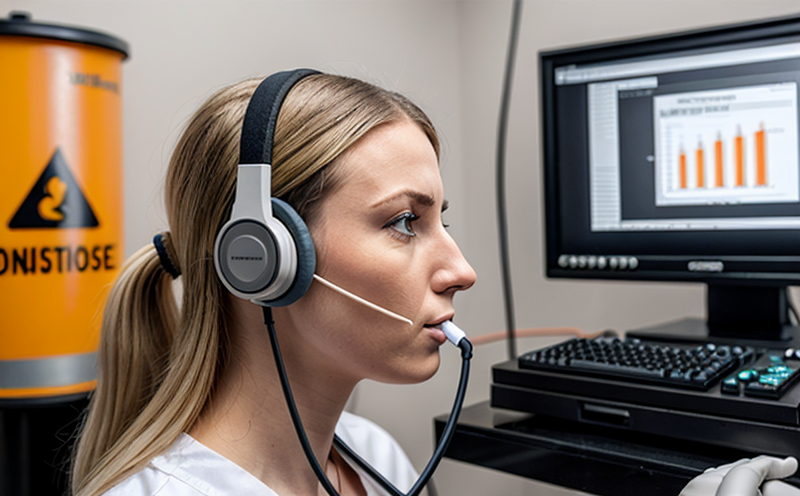ISO 4869-4 Active Noise Reduction Hearing Protection Testing
The ISO 4869 series is a suite of standards focused on noise reduction properties and performance assessment for hearing protectors. Among these, ISO 4869-4 specifically addresses the testing methodologies for active electronic components used in personal protective equipment (PPE) designed to reduce occupational noise exposure.
Active noise reduction (ANR) technology is an advanced feature that electronically cancels out background noise through a feedback loop. This technology relies on complex algorithms and sensitive sensors, making precise characterization critical for ensuring the safe and effective deployment of such devices in high-noise environments like manufacturing floors or construction sites.
The testing outlined in ISO 4869-4 is designed to evaluate the performance of ANR hearing protectors by measuring their ability to attenuate sound pressure levels. This involves both laboratory-based tests conducted under controlled conditions and field validation protocols that assess real-world effectiveness. The standard defines key performance indicators such as the noise reduction ratio (NRR) and the active attenuation level, which are essential for regulatory compliance.
For quality assurance teams, understanding these metrics is crucial. They help ensure that PPE meets stringent safety standards, thereby protecting workers from hearing damage caused by excessive occupational noise exposure. In this context, ANR devices play a vital role in reducing the overall noise levels perceived by wearers, thus enhancing worker well-being.
The testing process involves several critical steps. Specimens are prepared according to ISO 4869 guidelines, ensuring that each protector is standardized for measurement purposes. Laboratory tests typically include frequency-specific attenuation measurements and time-domain analysis of the ANR circuit’s response. Field testing then follows, where real-world noise conditions simulate typical industrial settings.
Accurate instrumentation such as sound level meters (SLMs) and data loggers are indispensable in capturing precise sound pressure levels both before and after application of ANR technology. This ensures that the reduction in perceived noise is accurately quantified. Reporting standards are equally important; they provide a clear, verifiable record of test results which can be used for compliance verification.
Compliance officers responsible for ensuring adherence to occupational health and safety regulations will find this testing particularly useful. By leveraging ISO 4869-4 methodologies, organizations not only meet regulatory requirements but also enhance their reputation through proactive risk management practices. For R&D engineers working on developing new ANR technologies, these tests serve as essential benchmarks against which product prototypes are evaluated.
Moreover, procurement teams can use the insights gained from this testing process to select suppliers who deliver high-quality PPE that effectively meets industry standards. This collaborative approach between different functional areas within an organization ensures not only compliance but also contributes to creating safer working environments for all employees.
Benefits
The implementation of ISO 4869-4 active noise reduction hearing protection testing brings numerous advantages across various sectors. Quality managers benefit from having robust data that supports the effectiveness and reliability of their products, which enhances brand reputation and customer trust.
Compliance officers gain peace of mind knowing they are meeting international safety standards set forth by ISO, reducing potential legal risks associated with non-compliance. R&D engineers can refine product designs based on detailed test results, leading to innovations that better suit specific industrial needs.
In terms of operational efficiency, companies adopting this testing method see reduced costs related to worker absenteeism due to hearing loss and improved productivity stemming from a healthier workforce. Procurement departments also enjoy cost savings through informed decision-making regarding supplier selection and equipment investment.
Industry Applications
This type of testing is particularly relevant in industries where workers are exposed to high levels of noise on a daily basis. These include manufacturing, construction, mining, aviation, and oil & gas sectors. In these environments, the use of active noise reduction hearing protectors helps mitigate risks associated with prolonged exposure to excessive sound pressure levels.
For example, in automotive plants where robotic welding stations produce loud noises during operation, workers may wear ANR headsets that reduce perceived sound intensity by up to 30 decibels. Similarly, aerospace manufacturers use similar technology to protect engineers working around jet engines during testing phases. In construction sites, electric tools like drills and jackhammers generate considerable noise; therefore, workers often rely on advanced hearing protection devices equipped with ANR capabilities.
The application of ISO 4869-4 ensures that these protective measures are consistently effective across different environments and circumstances. This consistency is vital for maintaining occupational health standards while also supporting productivity goals within these challenging industries.
Environmental and Sustainability Contributions
Incorporating ISO 4869-4 active noise reduction hearing protection testing into workplace practices contributes significantly to environmental sustainability efforts. By reducing the perceived noise levels experienced by workers, less reliance is placed on auditory alarm systems which can be energy-intensive.
Additionally, through improved communication and reduced stress among employees due to better hearing protection, there are fewer instances of accidents or errors that could lead to unnecessary waste production. The use of advanced materials in designing these protectors also promotes resource efficiency by extending product lifecycles and encouraging recycling practices.
Furthermore, companies adhering to this standard contribute positively towards reducing noise pollution outside the workplace as well. Workers who leave noisy environments with improved hearing are less likely to carry excessive sound levels into public spaces, thereby helping preserve overall ambient acoustic quality in communities surrounding industrial areas.





